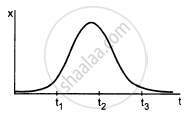Advertisements
Advertisements
प्रश्न
An object falling through a fluid is observed to have acceleration given by a = g – bv where g = gravitational acceleration and b is constant. After a long time of release, it is observed to fall with constant speed. What must be the value of constant speed?
उत्तर
When speed becomes constant acceleration a = `(dv)/(dt)` = 0
Given acceleration a = g – bv
Where, g = gravitational acceleration
Clearly, from the above equation as speed increases acceleration will decrease. At a certain speed say v0, acceleration will be zero and speed will remain constant.
Hence, a = g – bv0 = 0
⇒ v0 = g/b
APPEARS IN
संबंधित प्रश्न
Read the statement below carefully and state, with reason and example, if it is true or false:
A particle in one-dimensional motion with positive value of acceleration must be speeding up.
Suggest a suitable physical situation for the following graph:

The given figure gives a speed-time graph of a particle in motion along a constant direction. Three equal intervals of time are shown. In which interval is the average acceleration greatest in magnitude? In which interval is the average speed greatest? Choosing the positive direction as the constant direction of motion, give the signs of v and a in the three intervals. What are the accelerations at the points A, B, C and D?

If a particle is accelerating, it is either speeding up or speeding down. Do you agree with this statement?
In figure shows the x coordinate of a particle as a function of time. Find the sings of vx and ax at t = t1, t = t2 and t = t3.

The accelerations of a particle as seen from two frames S1 and S2 have equal magnitude 4 m/s2.
An object having a velocity 4.0 m/s is accelerated at the rate of 1.2 m/s2 for 5.0 s. Find the distance travelled during the period of acceleration.
The displacement of particle is given by x = `2/lambda (1 - e^(-lambdat))`, the acceleration of particle at 2s when λ = 2s–1 will be (Take `l`n 0.018 = – 4)
A lift is coming from 8th floor and is just about to reach 4th floor. Taking ground floor as origin and positive direction upwards for all quantities, which one of the following is correct?
Give example of a motion where x > 0, v < 0, a > 0 at a particular instant.
